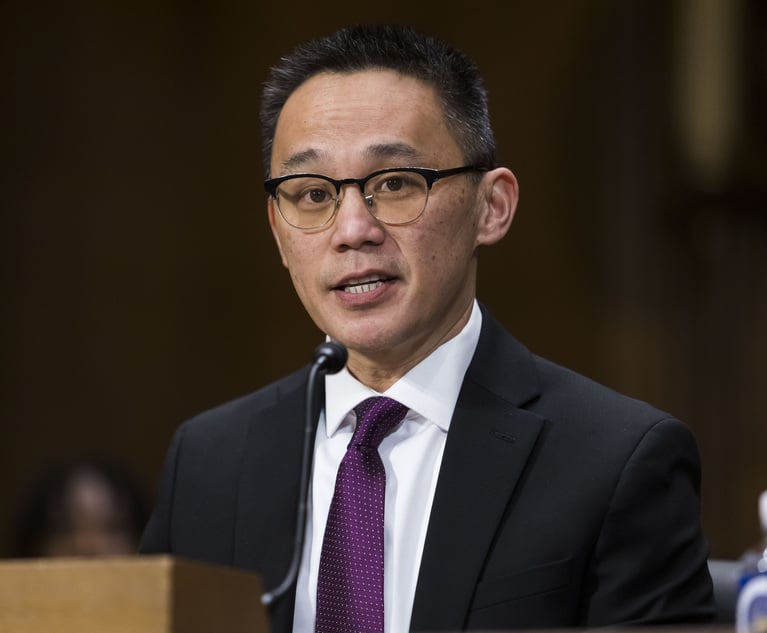Strategy, Storytelling and Cautionary Tales: Winston Litigator and Dallas Judge Spill Jury Trial Secrets
Two old friends teamed up to write a book on courtroom advocacy. The result is both wise and funny--and should be on every litigator's reading list.
November 07, 2017 at 09:26 PM
5 minute read
 L-R Thomas Melsheimer and Judge Craig Smith
L-R Thomas Melsheimer and Judge Craig Smith
For 25 years, Winston & Strawn partner Thomas Melsheimer and Dallas County Judge Craig Smith would get together after work and swap stories about their front-line experiences in court. Until one day, the old friends had a revelation: We should write a book.
The result, “On the Jury Trial,” was published in late October by the University of North Texas Press, combining specific examples with overarching strategies for effective advocacy. At 254 pages, it's not particularly long, but Melsheimer and Smith pack a tremendous amount of hard-earned wisdom into it. As a bonus, it's often rather funny. I've not seen a book quite like it before.
“We decided we didn't want a book of a bunch of war stories,” Melsheimer said. “We wanted to take what we've been learning and seeing in cases and craft something educational—not just for young lawyers, but lawyers of any stripe or age.”
 The managing partner of Winston's Dallas office, Melsheimer squeezed in writing time over an 18-month period, often on airplanes or sitting in airports, he said.
The managing partner of Winston's Dallas office, Melsheimer squeezed in writing time over an 18-month period, often on airplanes or sitting in airports, he said.
He drew on his unusually broad range of courtroom experience—he's tried cases involving everything from patent infringement to product liability to bank fraud. One of his highest-profile wins was in 2013 on behalf of billionaire entrepreneur Mark Cuban, who was completely cleared of insider trading charges by the U.S. Securities and Exchange Commission.
Smith, a former plaintiffs lawyer, has been a judge in the 192nd District Court in Dallas County since 2006. He's been president of the Texas Association of District Judges and was awarded trial judge of the year by the Dallas chapter of the American Board of Trial Advocates.
The book covers all major aspects of trying a case, but the chapter on the opening statement—“without question, the most important part of any jury trial,” the authors assert—is especially engaging.
It's a cliché to say an opening should “tell a story,” they write, noting that even experienced trial lawyers “sometimes make this point as if it is some profound discovery.” (I, for one, can vouch for that.)
And yes, of course, an opening should tell a story, but that's not enough—you've got to get the listener actually invested in the outcome of the case.
Melsheimer and Craig flag two concepts to do so: passion and reduction.
While an opening statement is not supposed to be an argument, that doesn't mean there's no room for passion.
“Why is passion important?” they write. “In our view, the single biggest compliment a trial lawyer can receive from a juror is this: 'Mr. Lawyer, you really seemed to believe what you were saying.' … [A] fundamental aspect of persuasion is for the listener to sense that the speaker really believes what she is saying.”
How to show passion? With your voice—raising it, lowering it, speaking more slowly or quickly for emphasis—or by using details to humanize your client, for example.
Their concept of reduction is also close to my heart. As a legal reporter, I'm constantly required to write a lead sentence that sums up a dispute. A lawyer should be able to do that too—even (or especially) if the case is complex.
“If you can't state your case in a single sentence, you are not going to be in a position to deliver a passionate opening statement that will invest the listener,” Melsheimer and Smith write. “By focusing on reducing your case to one sentence, you are framing the narrative into a statement the jury can remember and invest in. … Reduction does not mean important facts are glossed over or summarized in a superficial way. What follows from the 'reductionist' topic sentence will be evidentiary details.”
 They even tell you how to start: Just say “This case is about [blank].”
They even tell you how to start: Just say “This case is about [blank].”
One of the things that makes the book so interesting is that Melsheimer and Smith also use real-world examples from court transcripts (without the lawyers' names) of bad opening statements.
Among the no-nos: “Ponderous homages to the jury system.” Telling jurors what opening statements are. Saying you're “proud” to represent your corporate client. Too many PowerPoint slides. (“An opening statement should bear little resemblance to a boardroom presentation or to one given to a local PTA.”)
For example, they picked apart an opening in a wrongful death case, where the lawyer spent the first four minutes offering pearls like “In our system of government, we are entitled to trials by jury. The plaintiff is entitled to a trial by jury. The defendant is entitled to trial by jury,” and sucking up to the judge by saying things like “It has been a very big pleasure for me to be able to come here and appear before him.”
What the lawyer didn't do right out of the box, they write, “is frame his case for the jury as to why his client is not liable. He uses neither passion nor reduction. And he violates one of our 'rules' by stating that what he says is 'not evidence.' We have never found that useful.”
You can buy the book on Amazon, or order it off the website Onthejurytrial.com. All of the authors' proceeds benefit UNT Dallas College of Law.
This content has been archived. It is available through our partners, LexisNexis® and Bloomberg Law.
To view this content, please continue to their sites.
Not a Lexis Subscriber?
Subscribe Now
Not a Bloomberg Law Subscriber?
Subscribe Now
NOT FOR REPRINT
© 2024 ALM Global, LLC, All Rights Reserved. Request academic re-use from www.copyright.com. All other uses, submit a request to [email protected]. For more information visit Asset & Logo Licensing.
You Might Like
View All
Should It Be Left to the Plaintiffs Bar to Enforce Judicial Privacy Laws?
7 minute read
A Reporter and a Mayor: Behind the Scenes During the Eric Adams Indictment News Cycle

Of Predictive Analytics and Robots: A First-Year Federal Judge's Thoughts on AI
Trending Stories
- 1On the Move and After Hours: Brach Eichler; Cooper Levenson; Marshall Dennehey; Archer; Sills Cummis
- 2Review of Ex-parte orders by the Appellate Division
- 3'Confusion Where Previously There Was Clarity': NJ Supreme Court Should Void Referral Fee Ethics Opinion
- 4How Amy Harris Leverages Diversity to Give UMB Financial a Competitive Edge
- 5Pa. Judicial Nominee Advances While Trump Demands GOP Unity Against Biden Picks
Who Got The Work
Michael G. Bongiorno, Andrew Scott Dulberg and Elizabeth E. Driscoll from Wilmer Cutler Pickering Hale and Dorr have stepped in to represent Symbotic Inc., an A.I.-enabled technology platform that focuses on increasing supply chain efficiency, and other defendants in a pending shareholder derivative lawsuit. The case, filed Oct. 2 in Massachusetts District Court by the Brown Law Firm on behalf of Stephen Austen, accuses certain officers and directors of misleading investors in regard to Symbotic's potential for margin growth by failing to disclose that the company was not equipped to timely deploy its systems or manage expenses through project delays. The case, assigned to U.S. District Judge Nathaniel M. Gorton, is 1:24-cv-12522, Austen v. Cohen et al.
Who Got The Work
Edmund Polubinski and Marie Killmond of Davis Polk & Wardwell have entered appearances for data platform software development company MongoDB and other defendants in a pending shareholder derivative lawsuit. The action, filed Oct. 7 in New York Southern District Court by the Brown Law Firm, accuses the company's directors and/or officers of falsely expressing confidence in the company’s restructuring of its sales incentive plan and downplaying the severity of decreases in its upfront commitments. The case is 1:24-cv-07594, Roy v. Ittycheria et al.
Who Got The Work
Amy O. Bruchs and Kurt F. Ellison of Michael Best & Friedrich have entered appearances for Epic Systems Corp. in a pending employment discrimination lawsuit. The suit was filed Sept. 7 in Wisconsin Western District Court by Levine Eisberner LLC and Siri & Glimstad on behalf of a project manager who claims that he was wrongfully terminated after applying for a religious exemption to the defendant's COVID-19 vaccine mandate. The case, assigned to U.S. Magistrate Judge Anita Marie Boor, is 3:24-cv-00630, Secker, Nathan v. Epic Systems Corporation.
Who Got The Work
David X. Sullivan, Thomas J. Finn and Gregory A. Hall from McCarter & English have entered appearances for Sunrun Installation Services in a pending civil rights lawsuit. The complaint was filed Sept. 4 in Connecticut District Court by attorney Robert M. Berke on behalf of former employee George Edward Steins, who was arrested and charged with employing an unregistered home improvement salesperson. The complaint alleges that had Sunrun informed the Connecticut Department of Consumer Protection that the plaintiff's employment had ended in 2017 and that he no longer held Sunrun's home improvement contractor license, he would not have been hit with charges, which were dismissed in May 2024. The case, assigned to U.S. District Judge Jeffrey A. Meyer, is 3:24-cv-01423, Steins v. Sunrun, Inc. et al.
Who Got The Work
Greenberg Traurig shareholder Joshua L. Raskin has entered an appearance for boohoo.com UK Ltd. in a pending patent infringement lawsuit. The suit, filed Sept. 3 in Texas Eastern District Court by Rozier Hardt McDonough on behalf of Alto Dynamics, asserts five patents related to an online shopping platform. The case, assigned to U.S. District Judge Rodney Gilstrap, is 2:24-cv-00719, Alto Dynamics, LLC v. boohoo.com UK Limited.
Featured Firms
Law Offices of Gary Martin Hays & Associates, P.C.
(470) 294-1674
Law Offices of Mark E. Salomone
(857) 444-6468
Smith & Hassler
(713) 739-1250







